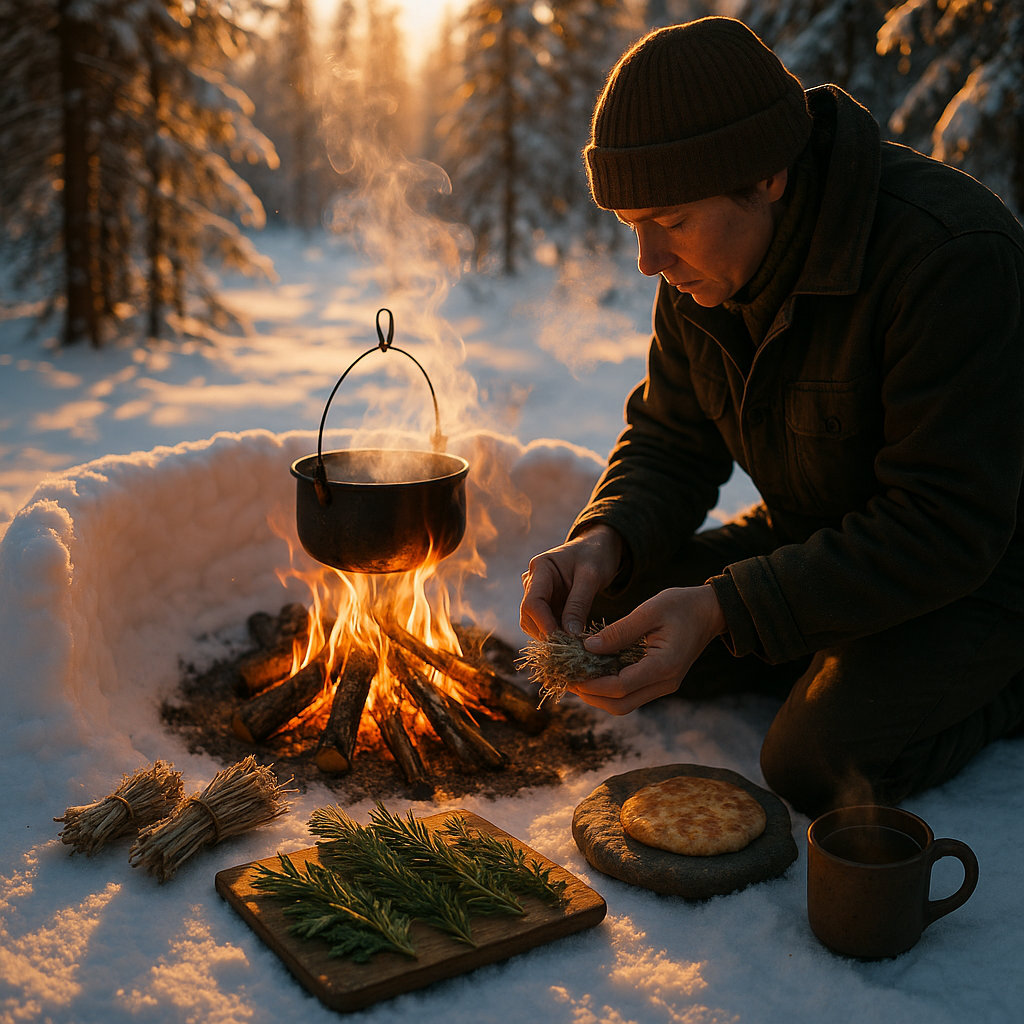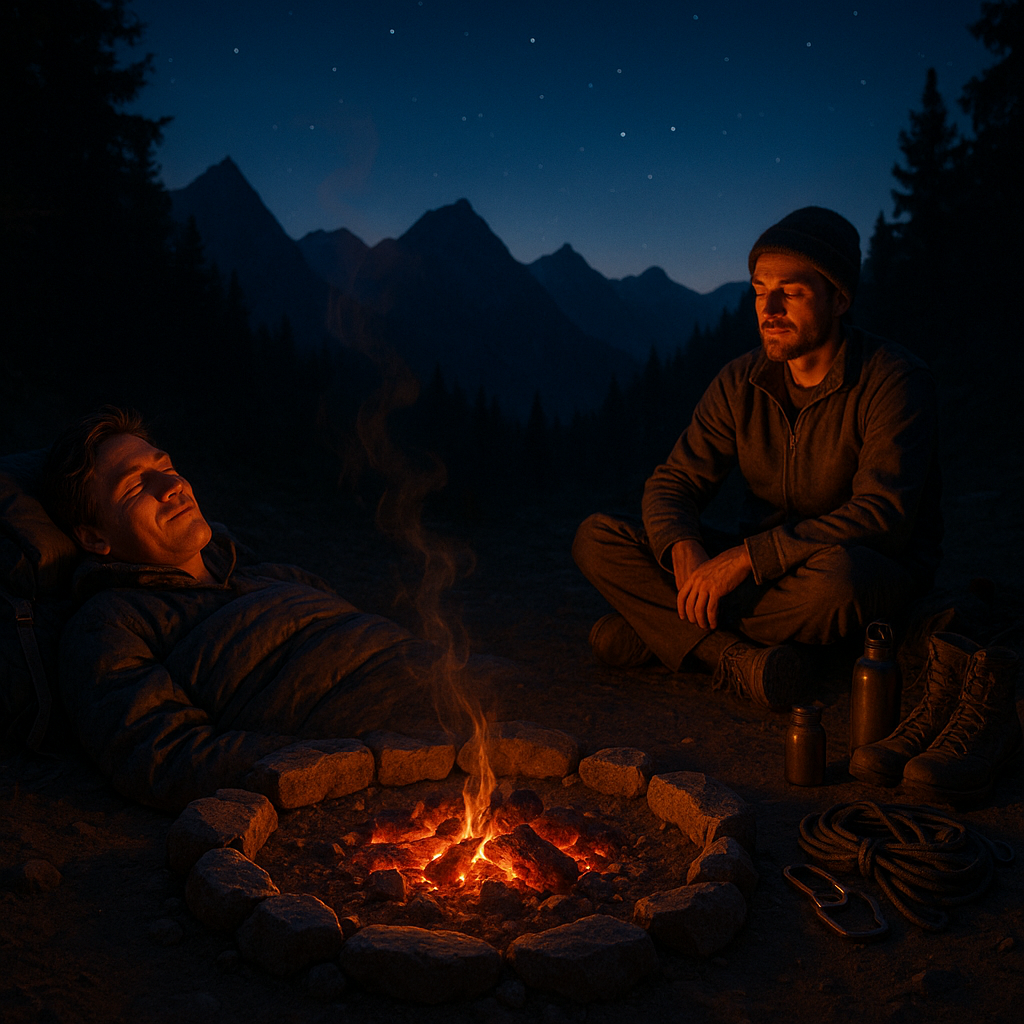Key Takeaways
Snow-capped landscapes spark a deep, primal wonder, beckoning those who yearn for authentic adventure beyond icy vistas and frozen delicacies. Snow cooking is more than survival; it is the art of transforming adversity into elemental exploration. Here, age-old wisdom meets wild creativity, unlocking the hidden power of medicinal herbs and the raw possibilities of a winter wilderness. As you step beyond the ordinary, these key insights reveal the untapped magic of snow cooking:
- Ignite fire with ancient remedies. Medicinal herbs such as sage, birch bark, and pine resin serve double duty as both powerful fire starters and time-honored healing agents. Their volatile oils and resins bring warmth, safety, and a flavor of tradition to even the coldest campsites.
- Collaborate with the snow. Snow itself becomes an essential tool. Packed snow forms natural windbreaks, sturdy cooking surfaces, and insulated shelters, turning the landscape into a functional and creative kitchen.
- Melt snow with intention, not haste. Using slow, steady heat and reflective barriers (often ignited with herbal tinder) ensures you draw pure, safe water from snow, conserving fuel and maximizing energy in challenging conditions.
- Nourish the body and spirit with smart meals. Opt for dishes that require minimal water and disperse warmth deeply, such as hearty stews and rustic bannock. These choices make the most of limited resources while providing sustaining comfort.
- Build winter-proof fires. Master the art of combining damp-resistant medicinal tinders with thoughtfully layered fire lays. This approach guards the flame against wind, moisture, and extreme cold. This is critical for successful outdoor winter cooking.
- Equip for the wild, and honor the experience. Long-handled utensils, compact cookware, and weatherproof ignition sources are invaluable. But just as important is a mindful appreciation for the wild, respecting the challenges and gifts of nature at every step.
- Rethink snow as a companion. When you see snow as a resource rather than an obstacle, it becomes your ally. It offers fresh water, structural support for fires, and a backdrop for transformative, communal feasts forged by fire and spirit.
Embracing snow cooking is a return to the world’s raw enchantment, where tradition, survival, and culinary adventure merge into unforgettable stories. Venture with us as we explore these time-honored techniques, herbal mastery, and soul-stirring moments that turn a snowbound landscape into your most wild and inspiring kitchen.
Introduction
As dawn breaks and fresh snow hushes the world, a rare clarity settles over the wilderness. Behind the silent, shrouded forest floor, there is fertile ground for ingenuity: snow cooking. Far from being mere endurance in the frozen wilds, it is a celebration of resourcefulness, a dance with nature’s ancient gifts, and an invitation to adventure.
The marriage of wisdom and practicality is evident in the use of wild medicinal plants like sage, birch bark, and pine resin (herbal fire starters that bridge the distance between time-honored remedies and modern survival). Every snow-lit meal becomes a reminder that sustenance is as much about the heart as the body. Let’s unveil how the natural pharmacy underfoot can spark not only flame but awe, and why the snow beneath us is an indispensable ally for those who answer the call of the winter wild.
Stay Sharp. Stay Ahead.
Join our Telegram Channel for exclusive content, real insights,
engage with us and other members and get access to
insider updates, early news and top insights.
 Join the Channel
Join the Channel
Reimagining Fire in the White: Harnessing Medicinal Herbs for Snow Cooking
Carving comfort and sustenance from winter’s embrace is an art, a living poetry where fire is born from the land’s most quietly potent offerings. When snow blankets every surface, the act of cooking is no longer routine; it is ritual, built upon resourcefulness, reverence, and a deeply felt connection to the living world. Here, each campfire constructed from earth’s secret pharmacy becomes both a hearth and a ceremony, echoing centuries of survival and kinship with the land.
Choosing and Preparing Herbal Fire Starters for Snowbound Meals
Medicinal herbs are renowned for their healing powers, but in the wilderness, their high oil and resin content transforms them into indispensable fire starters for the coldest nights. Their aromas, released in the moment of ignition, warm the senses and the soul.
Which Medicinal Herbs Burn Most Effectively in Damp Conditions?
- Sage: Its thick, evergreen leaves are rich with oils, making it a reliable, hot-burning fire starter. Even when cold or frosted, sage readily sizzles and crackles, emitting a purifying scent that lingers in winter air.
- Birch Bark: Technically an outer bark rather than a herb, birch peels off in curly strips and contains betulin, a natural resin that flares up energetically even when damp. It’s a go-to survival fire starter wherever birch trees stand.
- Rosemary: Sharp, camphor-rich needles yield a bright, pungent flame and add a fleeting savory aroma to the air before cooking commences.
- Juniper: Both the aromatic twigs and berries burn steadily, with a gentle, wild fragrance that adds a sense of place to your fireside meal.
- Pine Needles & Pine Resin: Pine forests, common in snowy regions, offer resin-rich “fatwood” and fragrant needles. The sticky resin catches a spark instantly, making it excellent tinder for melting snow and heating food.
To boost their spark, strip outer bark or crush the leaves to release volatile oils, especially when moisture is high or frost is thick.
Having identified these powerful herbal allies, the next question arises: which meals bring out the best in both these fire starters and winter’s stark beauty?
Winter Survival Cooking: Best Wilderness Meals for Snowbound Fires
Some meals do more than satisfy hunger; they kindle stories, evoke memories, and anchor us in place. In the context of snow cooking, pairing these nourishing dishes with herbal fire starters enriches both the meal and the experience.
What Wilderness Meals Suit Snow Cooking?
- Hot Stone Stews: Smooth stones, heated in herbal-scented embers, can be plunged into a foraged mix of greens, roots, and wild aromatics in snow-melt broth. The retained heat draws out deep flavors while creating delicious warmth.
- Wild Tea Infusions: Simple, soul-soothing teas made from sage, pine needles, and juniper berries, steeped in freshly melted snow water, bolster immunity and spirit alike.
- Forager’s Bannock: Hearty flatbread baked in the coals, enriched with a dusting of rosemary or birch ash, offers rustic sustenance and a tactile connection to the land.
- Charred Game or Fish: Whether it’s snow trout, venison, or wild rabbit, smoking or grilling over juniper and sage imparts unique, regional notes while preserving the deeply satisfying simplicity of the wild.
Each dish, woven with herbal smoke and steamy breath in the cold, strengthens the bond between wilderness and wanderer. As you savor the flavors, remember: every mouthful is a story, every fire a living memory. This culinary creativity naturally leads to another vital element: making the snow itself work for you as a crucial cooking resource.
Techniques for Melting Snow Efficiently for Cooking Water
Snow cooking is not just about patience; it’s about innovation. Turning snow into safe, flavorful water is more than melting, it’s about maximizing efficiency and ensuring your survival.
How Do You Purify Snow for Safe Consumption?
- Pack Before Melting: Always use clean, fresh snow. Compress it tightly to expel air and create a denser source for faster, more efficient melting.
- Layer Gradually: Start with a small amount of snow at the bottom to generate a liquid primer (this prevents scorching), then add more as it melts.
- Fuel with Herbal Fire Starters: Using sage, birch bark, or resinous pine keeps heat output high and stable, improving melt times even when the wind bites hard.
- Strain, Then Boil: Melted water should be filtered through cloth to remove soot and debris, then boiled for several minutes to purify from microbial threats.
- Enhance with Herbs: Toss in rosemary, sage, or pine needles as the snow melts. Not only do they impart flavor, but pine needles, for instance, add a dose of vitamin C. Subtle sustenance in every sip.
Real-world insight supports the value of these methods. Arctic adventurers and seasoned survivalists note that herbal fire starters, particularly resin-heavy pine, speed up melt times and reduce fuel needs dramatically. For example, during a 2018 Yukon expedition, trekkers who pre-dried sage and juniper increased daily water output by 20%, ensuring extra warmth and an important safety reserve.
With clean water and aromatic flames established, the wild offers its next lesson: crafting reliable, portable fire, no matter how deeply the snow falls.
Crafting and Using Herbal Tinder Bundles in Snowy Environments
The wisdom of gathering and preparing wild herbal tinder is one of the most essential winter survival arts. These small but mighty bundles are more than a bushcraft trick. They are insurance against the elements and a continuation of traditions that echo through time.
How to Make Herbal Tinder Bundles
- Gather Selectively: Seek out dry inner bark, resin-rich twigs, and woody herbs such as sage, pine, juniper, birch, and rosemary. If materials are damp, tuck them into your outer clothes to dry using body heat.
- Build the Bundle: Combine quick-lighting birch bark or pine fatwood with slower-burning, aromatic sage and rosemary. Bind the pieces together using natural fibers like dried grass or hand-twisted nettle cord.
- Prepare for Ignition: Fluff the ends to catch a spark easily, and crush the herbs slightly to release their essential oils.
- Ignite Strategically: Place the bundle below your prepared fire lay, protected from the wind. Both steel strikers and weatherproof matches work well with these bundles, which are ideal for snow-sheltered pits or reflective snow walls.
- Store Smart: Tuck a few completed bundles in waxed cloth or a small tin, safeguarding your ability to start a fire even in relentless wet or cold.
Outdoor experts like Tashi Stern, well-known for Appalachian winter expeditions, recount life-saving moments: “A palm-sized bundle of dried sage wrapped in birch bark saved me a dozen matches and delivered hot tea long after rain had soaked my fire kit.” This practice is as much about resilience as it is about reverence, tying every meal and night’s rest to the wild medicines at hand.
Conclusion
In the heart of winter, as snow settles and world turns nearly silent, snow cooking with medicinal herbs weaves necessity and celebration into a ritual of connection. These ancient allies (sage, birch, rosemary, juniper) offer more than warmth and flavor; they symbolically rekindle our partnership with nature, infusing even the simplest meal with story and meaning.
By mastering the craft of herbal fire starting and efficient snow-melt techniques, you do more than survive cold nights. You step into a tradition that honors both the land’s generosity and your own spirit of adventure. Each fireside meal, sparked by wild-grown tinder and sustained by the wisdom of herbal lore, becomes a quiet gesture of gratitude to the wilderness.
Looking ahead, those who embrace this elemental approach to cooking and survival will find themselves better equipped, both practically and emotionally, for the evolving challenges and wonders of the natural world. In every snowstorm and under every open sky, the true feast is found where food, fire, and freedom converge. This reminds us that the strongest bonds, and most vivid memories, are kindled in the raw, authentic beauty of the wild.
Links Inserted:
- herbal fire starters that bridge the distance between time-honored remedies and modern survival — Wild Healing Soups: Earth-Cooked Traditions & Foraged Ingredients Worldwide
- every mouthful is a story, every fire a living memory — One Pot Storytelling: Crafting Meaningful Meals Over Fire
- patience; it’s about innovation — Patience in Cooking: How Waiting Transforms Flavor and Experience
- mastering the craft of herbal fire starting — Field Curing: Rediscovering the Ancient Rituals of Firekeeping





Leave a Reply